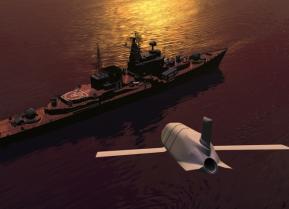LRASM: The Navy's New Anti-Ship Missile Is Aimed Right at China and Russia
The Long Range Anti-Ship Missile (LRASM) is Lockheed Martin’s advanced anti-ship missile, designed to replace the decades-old Harpoon. Developed through DARPA and based on the Joint Air-to-Surface Standoff Missile, LRASM can navigate complex defense systems autonomously, ensuring long-range precision.
What You Need to Know: The Long Range Anti-Ship Missile (LRASM) is Lockheed Martin’s advanced anti-ship missile, designed to replace the decades-old Harpoon. Developed through DARPA and based on the Joint Air-to-Surface Standoff Missile, LRASM can navigate complex defense systems autonomously, ensuring long-range precision. The weapon was built with Russia, China, or any nation that has solid naval capabilities in mind.
-The U.S. Navy is deploying it with the F/A-18 Super Hornet, and the Air Force with the B-1B Lancer. As tensions rise in the Pacific, the U.S. is ramping up LRASM production to address the gap in air-launched anti-ship weapons.
-With Lockheed aiming to produce 1,000 missiles annually, the LRASM strengthens America’s maritime defense posture against growing threats.
From Harpoon to LRASM: How the U.S. is Upgrading Its Anti-Ship Arsenal
The Long Range Anti-Ship Missile, or LRASM, is a DARPA-developed munition now in use with the U.S. Air Force and Navy.
The LRASM is launched from the air, typically from a fighter or a bomber aircraft. It will replace the Harpoon anti-ship missile, which has been the U.S.’s default option for almost 50 years.
LRASM: The Latest from Lockheed Martin
Lockheed Martin designed the LRASM. The company boasts that the weapon gives America enhanced abilities to deter and to defend. Specifically, the LRASM can “penetrate today’s sophisticated integrated air defense environments” thanks to “considerable precision routing, guidance and stealth” and can be used “day or night and in all weather conditions.”
To create the LRASM, Lockheed started with an existing product, their Joint Air-to-Surface Standoff Missile, and worked from there. The two products are similar, with Lockheed describing the new LRASM as a “precision-guided intelligent anti-ship missile design to interdict a variety of surface threats at very long range, navigating semi-autonomously to the target, and delivering a precise payload from safe, standoff range.”

The Navy is deploying the LRASM with its workhorse aircraft, the F/A-18 Super Hornet, and has begun testing the LRASM with the F-35C. Meanwhile, the Air Force is deploying the LRASM with the B-1B Lancer, although the B-1B is set to be retired soon and replaced with the B-21 Raider. The B-21 may not be compatible with the LRASM – the Raider is a stealth aircraft, a flying wing with internal weapons bays unlikely to accommodate the LRASM.
Preparing for the worst
According to Stacie Pettyjohn, director of defense programs at the Center for a New American Security, one of “the most glaring gaps in our portfolio is anti-ship weapons, especially air-launched ones,” meaning that the LRASMs are especially needed. “For several decades, we got out of the ship-killing business,” Pettyjohn said. “You actually do have to invest resources in it.”
The U.S. has been embroiled in a series of conflicts, none of which featured a naval element. But now, as the U.S. pivots toward Asia, and as China begins to assert its maritime territorial claims more ardently – and build ships at a history-making clip – the U.S. is lamenting its paltry stockpile of anti-ship missiles.
The need for the LRASM seems to be high enough that Lockheed is opening a second production line. The overdrive efforts to stockpile the anti-ship missile are a result of the LRASM’s positive testing and of the perceived need for anti-ship options. The second production line is expected to help Lockheed produce up to 1,000 units per year. Right now the Air Force is only planning to buy about 27 LRASMs in Fiscal Year 2024, but that number should increase gradually as production ramps up. Hopefully, however, the LRASM stockpile will not be needed, as any direct confrontation with China would be disastrous for all involved.
About the Author: Harrison Kass
Harrison Kass is a defense and national security writer with over 1,000 total pieces on issues involving global affairs. An attorney, pilot, guitarist, and minor pro hockey player, Harrison joined the US Air Force as a Pilot Trainee but was medically discharged. Harrison holds a BA from Lake Forest College, a JD from the University of Oregon, and an MA from New York University. Harrison listens to Dokken.
Image Credit: Creative Commons.


